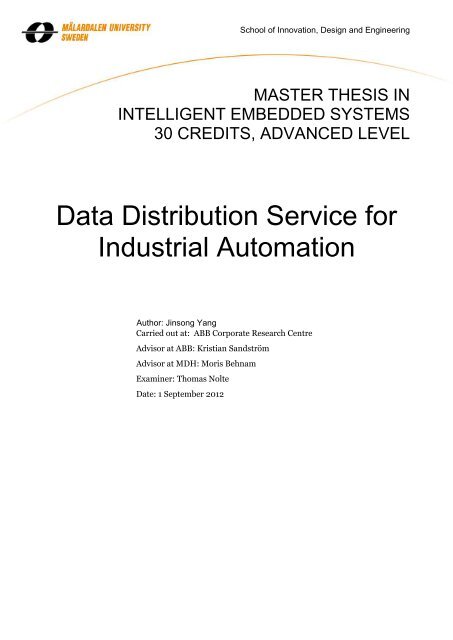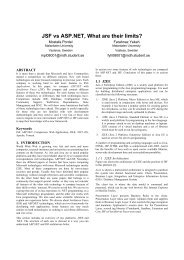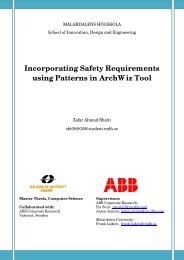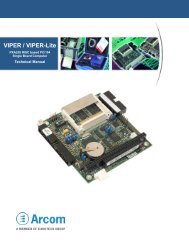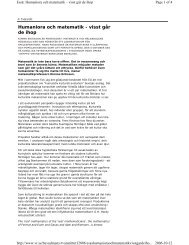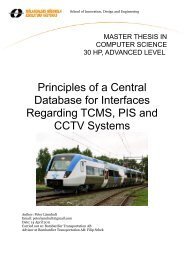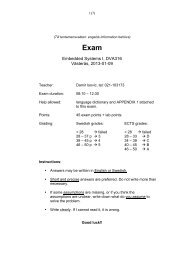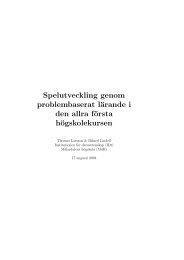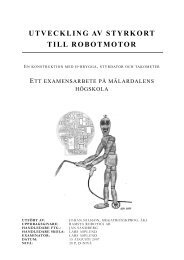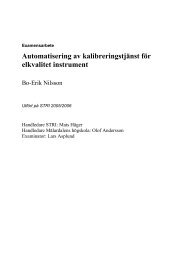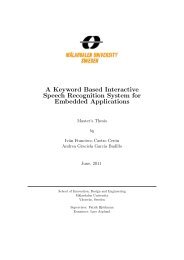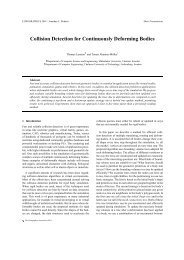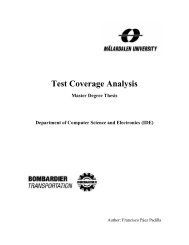Data Distribution Service for Industrial Automation - Research
Data Distribution Service for Industrial Automation - Research
Data Distribution Service for Industrial Automation - Research
Create successful ePaper yourself
Turn your PDF publications into a flip-book with our unique Google optimized e-Paper software.
School of Innovation, Design and Engineering<br />
MASTER THESIS IN<br />
INTELLIGENT EMBEDDED SYSTEMS<br />
30 CREDITS, ADVANCED LEVEL<br />
<strong>Data</strong> <strong>Distribution</strong> <strong>Service</strong> <strong>for</strong><br />
<strong>Industrial</strong> <strong>Automation</strong><br />
Author: Jinsong Yang<br />
Carried out at: ABB Corporate <strong>Research</strong> Centre<br />
Advisor at ABB: Kristian Sandström<br />
Advisor at MDH: Moris Behnam<br />
Examiner: Thomas Nolte<br />
Date: 1 September 2012
ABSTRACT<br />
In industrial automation systems, there is usually large volume of data which needs to be<br />
delivered to right places at the right time. In addition, large number of nodes in the<br />
automation systems are usually distributed which increases the complexity that there needs<br />
to be more point-to-point Ethernet-connections in the network. Hence, it is necessary to<br />
apply data-centric design and reduce the connection complexity. <strong>Data</strong> Distributed <strong>Service</strong> <strong>for</strong><br />
Real-Time Systems (DDS) is a data-centric middleware specification adopted by Object<br />
Management Group (OMG). It uses the Real-Time Publish-Subscribe protocol as its wiring<br />
protocol and targets <strong>for</strong> mission- and business-critical systems. The IEC 61499 Standard<br />
defines an open architecture <strong>for</strong> the next generation of distributed control and automation<br />
systems. This thesis presents the structure and key features of DDS and builds a model of<br />
real-time distributed system based on the IEC 61499 Standard. Then a per<strong>for</strong>mance<br />
evaluation of the DDS communication based on this model is carried out. The traditional<br />
socket-based communication is also evaluated to act as a reference <strong>for</strong> the DDS<br />
communication. The results of the evaluation mostly show that DDS is considered as a good<br />
solution to reduce the complexity of the Ethernet connections in distributed systems and can<br />
be applied to some classes of industrial automation systems.<br />
ii
PREFACE<br />
This project would not have been possible without the support of many people. First I<br />
would like to thank my supervisor Kristian Sandström at ABB Corporate <strong>Research</strong> Center,<br />
without whose research interest this project would not have been even started. I also want to<br />
express my gratitude to my examiner Thomas Nolte, with whom we had lots of interesting<br />
discussion and he gave me a lot of constructive advice. Gratitude is also due to my advisor<br />
Moris Behnam at Mälardalen University, who gave me a lot of useful advice during the<br />
writing process. Thanks to their ef<strong>for</strong>ts, we have the chance to present the results of the<br />
project in the IEEE Conference on Emerging Technologies and Factory <strong>Automation</strong> (ETFA)<br />
in Poland on September, 2o12.<br />
Deepest gratitude is due to Damir Isovic from Mälardalen University and Huifeng Wang<br />
from East China University of Science and Technology, who made my two years’ study in<br />
Sweden possible and wonderful. I would also convey my thanks to my Supervisor Hongbo Shi<br />
from East China University of Science and Technology, who has always supported and<br />
encouraged me to make progress in my study.<br />
I would like to express my love and gratitude to all my beloved families, <strong>for</strong> their<br />
understanding and endless love through the duration of my studies.<br />
Special thanks also to all the colleagues at Mälardalen University, at East China<br />
University of Technology and Science and at ABB Corporate <strong>Research</strong> Center, <strong>for</strong> their<br />
invaluable assistance.<br />
Västerås, August 2012<br />
Jinsong Yang<br />
iii
NOTATIONS<br />
Symbol<br />
Explanation<br />
OMG<br />
IEC<br />
DDS<br />
GDS<br />
RTPS<br />
SIFB<br />
DDSI<br />
DCPS<br />
DLRL<br />
QoS<br />
RTT<br />
JMS<br />
IDL<br />
PIM<br />
PSM<br />
Object Management Group<br />
International Electrotechnical Commission<br />
<strong>Data</strong> <strong>Distribution</strong> <strong>Service</strong> <strong>for</strong> Real-Time Systems<br />
Global <strong>Data</strong> Space<br />
Real-Time Publish-Subscribe<br />
<strong>Service</strong> Interface Function Block<br />
<strong>Data</strong> <strong>Distribution</strong> <strong>Service</strong> Interoperability protocol<br />
<strong>Data</strong> Centric Publish-Subscribe<br />
<strong>Data</strong>-Local Reconstruction Layer<br />
Quality of <strong>Service</strong><br />
Round Trip Time<br />
Java Messaging <strong>Service</strong><br />
Interface Definition Language<br />
Plat<strong>for</strong>m Independent Model<br />
Plat<strong>for</strong>m Specific Model<br />
iv
CONTENTS<br />
Chapter 1 INTRODUCTION 1<br />
1.1 Introduction .......................................................................................................... 1<br />
1.2 Objective ................................................................................................................ 1<br />
1.3 Problem Formulation ............................................................................................ 2<br />
1.4 Outlines ................................................................................................................. 2<br />
Chapter 2 BACKGROUND 3<br />
2.1 Background on IEC61499 Standard ..................................................................... 3<br />
2.2 Real-Time Publish-Subscribe Protocol ................................................................ 4<br />
2.2.1 Existing Communication Styles ................................................................................... 4<br />
2.2.2 Real-Time Publish Subscribe Protocol ....................................................................... 5<br />
2.3 Background on DDS .............................................................................................. 6<br />
2.3.1 DDS Standard ............................................................................................................... 6<br />
2.3.2 Core Entities of DDS .................................................................................................... 7<br />
2.3.3 Key Features of DDS .................................................................................................... 8<br />
2.3.4 Footprint of DDS Implementations .......................................................................... 10<br />
Chapter 3 RELATED WORK 12<br />
Chapter 4 MAPPING 14<br />
4.1 Mapping RTPS to IEC 61499 .............................................................................. 14<br />
4.2 Mapping the IEC 61499 Interface Declaration to the DDS Topic Declaration . 15<br />
4.3 Mapping Temporal Requirements on IEC 61499 Communication to DDS<br />
QoS ....................................................................................................................... 17<br />
Chapter 5 TEST SETUP 18<br />
5.1 Test Metrics ......................................................................................................... 18<br />
5.2 Test Setup ............................................................................................................ 18<br />
5.2.1 Network without Extra Load ...................................................................................... 19<br />
5.2.2 Network with Network Load ..................................................................................... 21<br />
Chapter 6 RESULTS AND ANALYSIS 23<br />
6.1 Results without Extra Networking Load ............................................................ 23<br />
6.2 Results with Networking Load .......................................................................... 30<br />
6.3 Integration Complexity ....................................................................................... 31<br />
Chapter 7 CONCLUSIONS 32<br />
Chapter 8 FUTURE WORK 33<br />
Chapter 9 REFERENCES 34<br />
v
Chapter 1<br />
INTRODUCTION<br />
1.1 Introduction<br />
In large scale industrial automation and control systems, a large number of controllers<br />
are usually distributed and connected with each other by an Ethernet-based network. The<br />
nodes in the network may share control data and interact with each other from different<br />
network hierarchy, including higher level operator stations. The inter-dependencies between<br />
these nodes may potentially create a complex architecture of the network in the distributed<br />
system especially if the point-to-point connection needs to be established. Moreover, most<br />
industrial automation systems need to be engineered with redundancy schemes, such as hot<br />
standby. The software components are duplicated on different nodes when the hot standby is<br />
used, which further increases the complexity of the network connections in the system.<br />
Publish-subscribe model shows some appealing properties [1], such as connectionless and<br />
multicast, that can be used to reduce some of the visible complexity in the software systems.<br />
DDS [2] is an open specification of data-centric middleware defined by OMG to<br />
standardize the real-time publish subscribe communication model. This specification is<br />
designed to address the mission- and business- critical systems and has been widely used in<br />
both commercial and administrative field, including US Navy, EuroControl, etc. Some<br />
properties of DDS suggest the possibility to be used in the communication of the industrial<br />
distributed control systems.<br />
It is essential to consider the applicability when introducing a new communication<br />
strategy in industrial distributed control systems. Communication strategy that is applicable<br />
to an international standard could be widely adopted by different vendors and users. IEC<br />
61131 [3] and 61499 [4] are international standards <strong>for</strong> industrial automation. This work will<br />
focus on IEC 61499.<br />
The IEC 61499 Standard defines an open architecture <strong>for</strong> the next generation of<br />
distributed control and automation systems. This standard provides component model with<br />
the basic unit function block, which has separate event and data interfaces. Based on function<br />
block, a system can be assembled by network of function blocks. IEC 61499 also defines some<br />
special function blocks to provide special services. For example, communication <strong>Service</strong><br />
Interface Function Block (SIFB) is defined to achieve communication between different<br />
applications [4]. IEC 61499 is already used in quite a few products and there are some tools<br />
to develop IEC 61499 compliant applications.<br />
This work would focus on apply DDS to an IEC 61499 compliant model.<br />
1.2 Objective<br />
This work focuses on applying DDS in the context of IEC 61499. The specific objectives<br />
are to: 1) present the structure and key feature of DDS, 2) map node-to-node communication<br />
1
in IEC 61499 to the DDS real-time publish-subscribe model including mapping timing<br />
requirements to QoS attributes of the publish-subscribe model, and 3) evaluate the<br />
per<strong>for</strong>mance of DDS communication while comparing it with the more traditional socketbased<br />
Ethernet communication.<br />
1.3 Problem Formulation<br />
As the industrial distributed control systems are usually large systems consisted of<br />
thousands of nodes deployed from different location, the communications between the nodes<br />
in the systems could be very complicated. For example the traditional socket-based Ethernet<br />
communication requires point-to-point connection, which is complex and the complexity<br />
could raise deployment risk during integration. It would be very interesting if a solution can<br />
be found to simplify the connections and at the same time maintain the per<strong>for</strong>mance of the<br />
systems.<br />
There<strong>for</strong>e, this thesis focuses on exploring the communication styles and tries to<br />
evaluate and find a solution that can simplify the communication and at the same time<br />
maintain the per<strong>for</strong>mance of the system.<br />
1.4 Outlines<br />
The outline of this thesis is as follows: Chapter 2 describes the background of DDS and<br />
IEC61499 Standard. Chapter 3 presents some related work. Chapter 4 explains the mapping<br />
of IEC 61499 communication to DDS as well as the QoS. Chapter 5 explains the test setups<br />
and the per<strong>for</strong>mance evaluation is given in Chapter 6. In Chapter 7, conclusions will be<br />
drawn and Chapter 8 discusses about the future work.<br />
2
Chapter 2<br />
BACKGROUND<br />
This Chapter gives the background of IEC 61499 Standard and RTPS protocol. As a new<br />
enabling technology, DDS is introduced in detail including: structure, core entities, key<br />
features and footprint.<br />
2.1 Background on IEC61499 Standard<br />
As an international standard <strong>for</strong> industrial control and automation systems, IEC 61499<br />
is consisted of 4 parts. Part 1 is about architecture, which defines the models and provides the<br />
declaration, configuration, usage and management of function blocks. Part 2 is about<br />
software tool requirements, which specifies the requirements of software to support IEC<br />
61499 Standard. Part 3 gives some tutorial in<strong>for</strong>mation to help users understand and use the<br />
standard by examples. Part 4 defines the rules <strong>for</strong> the compliance profile like the<br />
interoperability and portability [4].<br />
The IEC 61499 Standard provides reference models <strong>for</strong> systems, devices, resources,<br />
applications, function blocks, distribution, managements and operation states.<br />
Figure 1. Structure of IEC 61499 Basic Function Block (see [4])<br />
Function block is the key definition of IEC61499 Standard, as it is the basic unit of a<br />
distributed control system. Function block is defined to be a functional unit of software which<br />
can be connected to other function blocks to make up an application. IEC 61499 defines two<br />
types of function blocks, basic function block and composite function block. A composite<br />
3
function block is consisted of several other function blocks. Network of function blocks can<br />
be assembled to be an application and applications can be assembled to a distributed system.<br />
Figure 1 shows the structure of basic function block. The function block separates event<br />
and data inputs. When the function blocks are assembled to application, the application can<br />
have separate event and data flow. However, each event is associated with none or more data.<br />
Each function block has algorithms that can be triggered by the events and are used to<br />
compute the output based on the input. These algorithms can be defined by Structural Text,<br />
C++ or Java, depending on which development tool is used.<br />
Some special function blocks – <strong>Service</strong> Interface Function Blocks (SIFBs) are defined to<br />
provide services. A SIFB is a function block that provides services to an application, which is<br />
based on a mapping of service to the function block’s event and data input/output. There are<br />
two types of SIFB: the communications SIFBs are used to define communication while the<br />
management SIFBs are defined <strong>for</strong> management of applications and behaviours of functions.<br />
There are already some IEC 61499 compliant development environments, like Function<br />
Block Development Kit (FBDK) [5], FBench [6], 4DIAC [7]. Most of them provide<br />
development of function blocks with separate event- and data-flow in C++ or Java and<br />
programming of algorithms using C++, Java or Structural Text. However, they still need<br />
more documentation and flexibility about these tools.<br />
2.2 Real-Time Publish-Subscribe Protocol<br />
This section talks about the existing communication styles and addresses the strength of<br />
Real-Time Publish Subscribe Protocol.<br />
2.2.1 Existing Communication Styles<br />
In distributed systems, there are different communication styles according to different<br />
purpose and requirements. Most of the distributed systems can be viewed as independent<br />
components but interact with each other using communication styles like client-server,<br />
publish-subscribe, peer to peer, service oriented style, etc. [8].<br />
Client-server style [9]. In<strong>for</strong>mation <strong>for</strong> the client-server style is usually managed and<br />
exchanged centrally. The communication is usually achieved by request from the client to the<br />
central server with explicit connection. Figure 2 shows the connection of client-server style.<br />
Figure 2. Client-server style<br />
Peer-to-peer style [9]. Different from client-server style, peer-to-peer establishes<br />
connection between clients without central server. Every node in the network can offer and<br />
consume in<strong>for</strong>mation. In addition, any node can join or leave the network at any time. Since<br />
no central server used, it avoids single point of failure. Figure 3 shows the connection of pure<br />
peer-to-peer style. There is also some combination between peer-to-peer network and clientserver.<br />
4
Figure 3. Pure peer-to-peer style<br />
Publish-subscribe style [9]. The styles above are both based on explicit connections.<br />
Alternatively publish-subscribe style uses an implicit invocation mechanism which is a manyto-many<br />
network. The nodes (publishers/subscribers) are associated to each other by runtime<br />
events (topics) and this is called subscription. Many publish-subscribe systems use an<br />
intermediate broker to realize this subscription. The communication between associated<br />
publishers and subscribers can happen when this event takes place. Figure 4 shows the<br />
structure of the publish-subscribe style.<br />
Figure 4. Publish-subscribe with broker<br />
All of these communication styles have their own pros and cons when applied to a<br />
specific field. Sometimes a combination between them could be a fair solution <strong>for</strong> a particular<br />
problem. However client/server based socket communication is the most common choice in<br />
industry; especially the TCP based socket communication, which can establish a reliable<br />
communication.<br />
2.2.2 Real-Time Publish Subscribe Protocol<br />
The Real-Time Publish Subscribe (RTPS) protocol [10] is a part of the Real-Time<br />
<strong>Industrial</strong> Ethernet Suite IEC-PAS-62030 approved by IEC. This protocol has been widely<br />
used in thousands of industrial applications. The RTPS Wire protocol is mainly composed<br />
with the publish-subscribe protocol and Composite State Transfer (CST) protocol. The<br />
publish-subscribe protocol transfers data, while the CST transfers state.<br />
5
The RTPS protocol aims to run over connectionless best-ef<strong>for</strong>t transport with support of<br />
multicast such as UDP/IP. It supports the unique requirements of data-distribution systems.<br />
Compared with traditional publish-subscribe, there are more real-time requirements on it. It<br />
is specified in both a Plat<strong>for</strong>m Independent Model (PIM) and a set of Plat<strong>for</strong>m Specific Model<br />
(PSM), which indicates that RTPS can run on different transport plat<strong>for</strong>m. The main features<br />
of RTPS are listed below:<br />
• Per<strong>for</strong>mance and QoS properties: RTPS properties support RTPS to be run on both<br />
reliable and best-ef<strong>for</strong>t communications. The QoS policies give the users the flexibility to<br />
specify and control the communication behaviours.<br />
• Fault tolerance: This property ensures the robustness of the system and avoids single<br />
points of failure.<br />
• Extensibility: Some parts of the RTPS protocol can be extended.<br />
• Plug-and-play connectivity: All the nodes can join or leave the network at any place<br />
and time.<br />
• Scalability: Due to the connectionless and dynamic discovery properties, the system<br />
can easily be scaled to large number of nodes.<br />
These properties of RTPS perfectly meet the requirements of DDS wire-protocol [10].<br />
2.3 Background on DDS<br />
DDS, as a publish-subscribe middleware standard was approved by OMG in 2003 and in<br />
the past a few years, it has been improved and enhanced. Nowadays, it has already been used<br />
in both commercial and administrative applications. DDS defines a programming model of<br />
RTPS protocol <strong>for</strong> distributed systems and has been implemented by several different<br />
vendors according to different applications.<br />
2.3.1 DDS Standard<br />
The OMG DDS defines a programming model including a wire protocol and a set of<br />
standard APIs. This standard includes the DDS Interoperability Wire Protocol [10] and DDS<br />
API [2]. Figure 5 shows the structure OMG DDS standard. The current working version of<br />
DDSI is 2.1 and the DDS API version is 1.2. However, DDS API Version 1.3 is now under<br />
revision [11].<br />
The DDS Interoperability Wire Protocol Specification (DDSI) defines the<br />
interoperability protocol <strong>for</strong> DDS. DDS uses RTPS protocol as an underlying data transport<br />
protocol and all vendors of DDS follow this wire protocol, which ensures that different<br />
vendors’ implementations of DDS can interoperate.<br />
The DDS API standard provides the standard interface between DDS and applications.<br />
This standard ensures the source code portability between different vendor implementations.<br />
Currently OMG provides the standard DDS API interface in C, C++ and Java languages.<br />
Lower level <strong>Data</strong>-Centric Publish-Subscribe (DCPS) is intended <strong>for</strong> efficient delivery of<br />
in<strong>for</strong>mation. DCPS minimizes the need <strong>for</strong> data copy and dynamic resource allocation, which<br />
is predictable and efficient. Actually this layer defines all the activities <strong>for</strong> DDS<br />
communication, <strong>for</strong> example, defining topics, creating publisher/subscriber entities,<br />
writing/reading data, etc.<br />
Optional higher-level <strong>Data</strong>-Local Reconstruction Layer (DLRL) provides more direct<br />
access to the exchanged data and simpler integration with the local language constructs.<br />
NDDS from Real-Time Innovations [12] and Splice from Thales Naval Nederland [13] are<br />
6
commercial implementations implemented not only the DCPS, but partially DLRL as well,<br />
though no standardized interfaces are provided [10].<br />
The light-weighted UDP/IP is used as a transport <strong>for</strong> DDS as it has the following<br />
characteristics: universal availability, best-ef<strong>for</strong>t, connectionless, predictable behaviour,<br />
scalability and multicast support. Although DDS can also be implemented using other<br />
transport plat<strong>for</strong>m, it is supposed to work best over UDP/IP [10].<br />
Figure 5. OMG DDS standard structure<br />
2.3.2 Core Entities of DDS<br />
Figure 6 shows the global view of a DDS system with 3 domain participants and two<br />
topics. It shows almost all the important entities of DDS, such as data writer, data reader,<br />
publisher, subscriber, etc.<br />
Figure 6. OMG DDS global view<br />
7
Global <strong>Data</strong> Space (GDS) [2]: GDS is an abstraction of data space where all the data can<br />
be stored. Applications who want to publish or modify the data need to be publisher and who<br />
want to receive and use the data need to be subscriber. There are different domains in the<br />
GDS and each domain can be further divided into different partitions logically. Domains<br />
between themselves are isolated, so an entity (like topic) can only be in one domain, but can<br />
appear in several partitions. The GDS needs to be fully distributed so as to avoid single points<br />
of failure <strong>for</strong> the systems.<br />
Domain participant [2]: A domain participant is a representation of membership of the<br />
application in the domain, while a domain is a concept that links all the applications together<br />
so that they could communicate. Domain participant is the container <strong>for</strong> all other entities and<br />
isolates applications from each other when there are multiple applications running on the<br />
same node.<br />
Publisher and data writer [2]: A publisher is defined to be an object <strong>for</strong> data<br />
distribution which publishes data into the GDS. But publisher itself could not do that, it can<br />
only publish data using data writer. <strong>Data</strong> writer is always associated with a publisher. A<br />
publisher may contain different typed data writers to publish different data types.<br />
Subscriber and data reader [2]: A subscriber is defined to be an object to receive data<br />
from the GDS. It could not directly access the data as well, so it has to receive data via data<br />
reader. <strong>Data</strong> reader is always associated with a subscriber. A subscriber may have many<br />
different data readers.<br />
Topics [2]: A topic is defined to be the object to associate publishers and subscribers and<br />
it is usually consisted of a unique name, a data type and a set of QoS. Only when a subscriber<br />
is subscribed to the same topic that a publisher has published, the message can be written by<br />
the data writer or read by the data reader. Besides, another requirement is that the QoS of the<br />
publisher and subscriber needs to be compatible.<br />
QoS [2]: Every entity of the DDS has a set of QoS, so the endpoints of the<br />
communication can only communicate when they have compatible QoS configuration. DDS<br />
provides a rich set of QoS policies, ranging from data availability, data delivery, data<br />
timeliness to resources and configuration.<br />
Overall, DDS is designed to be scalable and configurable with a rich set of QoS <strong>for</strong> realtime<br />
distributed systems.<br />
2.3.3 Key Features of DDS<br />
As a networking middleware, DDS provides a model <strong>for</strong> sending and receiving messages,<br />
events and commands in the network. The key features [10] are presented as below:<br />
<strong>Data</strong>-centric middleware. DDS is a data-centric middleware and a fully distributed GDS<br />
is adopted to store the data. Thus DDS could improve the communication time and avoid<br />
single point of failure.<br />
Connectionless. DDS utilizes the real-time publish-subscribe protocol, which is<br />
connectionless. Thus there is no need to establish point-to-point connection in the network.<br />
Compared with traditional point-to-point connection, DDS requires low cost to integrate a<br />
large system.<br />
Automatically discovery. With DDS, the nodes in the network are anonymous to each<br />
other, so they can join or leave the network at any time. Subscribers <strong>for</strong> the application can<br />
subscribe to a topic at anytime and anywhere.<br />
Explicit model. For applications it is not necessary to know the communication<br />
mechanism of the DDS, as DDS will handle message packing, delivery, unpacking, etc.<br />
8
Interoperability. DDS is a standard model with interoperability and the interoperability<br />
is achieved via the standard DDS API, the RTPS wire protocol and the QoS. The RTPS wire<br />
protocol is essential to the interoperability of DDS as it specifies the important aspects of<br />
DDS, including dynamic discovery, plat<strong>for</strong>m independence, etc. The standard DDS API<br />
ensures the portability between DDS middleware and the application, while the QoS provides<br />
different configurations of QoS to fulfill different requirements [14]. Over all, these three<br />
aspects define all the necessary parts of the standard and ensure the interoperable<br />
implementation of DDS. With this feature, the users can easily choose different<br />
implementation from different vendors.<br />
Rich set of QoS policies. DDS provides a rich set of QoS, with which users can specify<br />
and control the behavior of the communication. The QoS policies can be configured to all<br />
DDS entities like publisher, subscriber, data writer, data reader, topic and so on. The DDS<br />
communication can only be established when the QoS configurations are compatible between<br />
the publisher and subscriber. In fact, the QoS policy follows the subscriber-requested,<br />
publisher-offered pattern. Table 1 shows the supported QoS policies. These QoS parameters<br />
show concerns to different aspects of DDS, including data delivery, data availability, data<br />
timeliness, configuration and resources.<br />
Table 1. Supported QoS polices (see [2])<br />
QoS Policy Meaning Concerns RxO Changeable<br />
USER_DATA<br />
TOPIC_DATA<br />
GROUP_DATA<br />
DURABILITY<br />
DURABILITY_<br />
SERVICE<br />
LIFESPAN<br />
HISTORY<br />
DEADLINE<br />
LATENCY_<br />
BUDGET<br />
TRANSPORT_<br />
PRIORITY<br />
OWNERSHIP<br />
User data not known by middleware,<br />
but distributed by built-in topics<br />
Defines whether to keep the data<br />
samples <strong>for</strong> late-joining data reader<br />
or not.<br />
Configuration of the durability<br />
service<br />
The maximum valid duration of an<br />
data instance<br />
Determines whether to deliver the<br />
most recent value or all the<br />
intermediate changes<br />
Write or receive a new sample at<br />
least once every deadline period<br />
Specifies the maximum acceptable<br />
delay that the from the data written<br />
until received by data reader<br />
Hint to set the priority of the<br />
underlying transport<br />
Decides whether and how multiple<br />
data writers are allowed to modify an<br />
DP, DR, DW No Yes<br />
Topic<br />
Publisher,<br />
Subscriber<br />
Topic, DR, Yes No<br />
DW<br />
Topic, DW No No<br />
Topic, DW N/A Yes<br />
Topic, DR, No No<br />
DW<br />
Topic, DR, Yes Yes<br />
DW<br />
Topic, DR, Yes Yes<br />
DW<br />
Topic, DW N/A Yes<br />
Topic, DR, Yes No<br />
DW<br />
9
OWNERSHIP_<br />
STRENGTH<br />
LIVELINENESS<br />
PRESENTATION<br />
instance.<br />
Specifies the value of the strength to<br />
arbitrate which data writer to modify<br />
the instance.<br />
Determines whether an entity is still<br />
active<br />
Specifies how to present the change<br />
of instance to subscribers<br />
DW N/A Yes<br />
Topic,<br />
DW<br />
Publisher,<br />
subscriber<br />
PARTITION Logical partition of the topics Publisher,<br />
Subscriber<br />
DR,<br />
RELIABILITY Specify the level of reliability Topic, DR,<br />
DW<br />
DISTINATION_<br />
ORDER<br />
RESOURCE_<br />
LIMITS<br />
TIME_BASED_<br />
FILTER<br />
Determines the logical order of the<br />
changes made to the instance<br />
Specifies the resource available to be<br />
consumed<br />
To specify the interest of a particular<br />
subset of the data instances<br />
Topic,<br />
DW<br />
Topic,<br />
DW<br />
DR,<br />
DR,<br />
Yes<br />
Yes<br />
No<br />
Yes<br />
Yes<br />
No<br />
No<br />
No<br />
Yes<br />
No<br />
No<br />
No<br />
DR N/A Yes<br />
These QoS parameters mainly focus on the following aspects: data availability, data<br />
delivery, data timeliness, resources and configuration.<br />
2.3.4 Footprint of DDS Implementations<br />
There are quite a few DDS implementations from different vendors. Among them are<br />
Real-Time Innovation (RTI), PrismTech [15] and Twin Oaks [16], who have implemented<br />
DDS and used it <strong>for</strong> commercial purposes. PrismTech also offers an open source version of<br />
their implementation, OpenSplice DDS Community, which will be used in the per<strong>for</strong>mance<br />
evaluation of this paper.<br />
DDS has been implemented with different size due to different purpose. CoreDX is a<br />
light-weighted version from Twin Oaks Computing, which is available <strong>for</strong> embedded space. It<br />
is developed directly with native Operating System interfaces using C language, which can<br />
reduce latency. Also due to its modular design, the DDS feature can be reconfigured by the<br />
user according to the requirements. Thus the library can be measured in kilobytes.<br />
CoreDX requires only small runtime memory as it is able to run on a single Intel<br />
Pentium CPU with 640 KB memory. An application with 1 domain participant, 6 topics, 6<br />
data writers and 4 data readers requires less than 100 KB heap memory [17]. Thus it is able to<br />
run on embedded plat<strong>for</strong>ms.<br />
Connext DDS from RTI is a full implementation of DDS standard and it can be run on<br />
multithreaded operating systems like Windows, Linux, VxWorks, etc. It requires 250 MB disk<br />
and 256 MB memory [18]. Also it has a subset ConnextMicro, of which the source code is<br />
around 130 KB and 20.000 lines. There<strong>for</strong>e it is possible <strong>for</strong> it to run on many single-chip,<br />
32-bit microcontrollers [19].<br />
PrismTech provides one commercial and one open source version both with full<br />
implementation of OMG DDS. The open-source version Opensplice DDS Community 5.4.1<br />
10
support Windows CE 6.0 armv4i plat<strong>for</strong>m and VxWorks 5.5.1 Pentium target hosted on<br />
WindowsXP [20]. For this implementation, it requires at least 2 MB of shared memory.<br />
11
Chapter 3<br />
RELATED WORK<br />
This Chapter presents related work on DDS and IEC 61499 Standard.<br />
Schmidt and Hag first introduced the key features of OMG DDS [2] standard and then<br />
introduced the implementation of Opensplice DDS. They also introduced the use cases of<br />
Opensplice DDS in TACTICOS combat management system built on top of Opensplice DDS<br />
and it is also selected as the publish/subscribe middleware <strong>for</strong> distributing flight data plans<br />
in next generation European Flight <strong>Data</strong> Processor – CoFlight [21]. That indicates that OMG<br />
DDS is mature and has already been used in the defense system and flight control system.<br />
This thesis tries to explore the possibility of applying this middleware in industrial<br />
automation systems.<br />
Castellote not only introduced the main aspects of the DDS model, but also described the<br />
relationship between DDS and other OMG specifications like the Notification <strong>Service</strong> and the<br />
High-Level Architecture (HLA) [22]. This thesis will focus on the per<strong>for</strong>mance evaluation and<br />
application DDS to IEC 61499 Standard.<br />
Guesmi et al. presented an implementation of DDS-based middleware <strong>for</strong> real-time<br />
control systems. They provided a new scheduling strategy as a solution <strong>for</strong> data distribution.<br />
This strategy consists of an algorithm <strong>for</strong> determining scheduling parameters and a real-time<br />
scheduler based on DDS QoS policies such as deadline, transport priorities. This<br />
implementation used real-time network (CAN) as transport. Together with the EDF<br />
scheduling strategy, this implementation is adapted with soft real-time network [23]. Rekik<br />
and Hasnaoui presented a detailed implementation of DDS API on a CAN bus transport. This<br />
implementation could use CAN bus to send a number of sensor data samples in one message<br />
and the connectionless DDS property is well suited <strong>for</strong> complex distributed system [24].<br />
Agirre et al. suggested an additional layer on top of the DDS middleware, to provide<br />
application management functionalities with QoS support <strong>for</strong> real-time distributed systems.<br />
These application managements include application deployment, maintenance, execution<br />
control, final un-installation. Besides, this layer also provides QoS reconfiguration and fault<br />
tolerance [25]. Though this additional layer has the advantage to ease the application<br />
managements, however it further raises the use complexity of the DDS middleware. Also the<br />
manually deployment of the executable code currently does not support remote software<br />
updating.<br />
Joshi compares Java Message <strong>Service</strong> (JMS) with DDS and provides a mapping between<br />
JMS and DDS. Both JMS and DDS are publish-subscribe model based middleware with a<br />
standard API, so the user experience of both middleware are similar. However, DDS is<br />
targeted <strong>for</strong> real-time systems while JMS is targeted <strong>for</strong> enterprise systems. In addition, they<br />
use different paradigms. JMS uses autonomous message as data model while DDS uses dataobject.<br />
JMS uses destination (acts as “mini-broker”) to manage the message delivery while<br />
DDS just needs endpoints matching. JMS is reliable and always tries to receive<br />
acknowledgement while DDS does not. So JMS is best <strong>for</strong> TCP based transport and DDS is<br />
12
ased <strong>for</strong> UDP based best-ef<strong>for</strong>t transport. JMS and DDS have much difference, but they can<br />
be used at the same application when necessary [26]. Even though both of JMS and DDS use<br />
publish-subscribe model, they are developed <strong>for</strong> different purpose with different paradigms.<br />
In this project, DDS is used alone.<br />
Thramboulidis et al. proposed an IEC-compliant field device model <strong>for</strong> distributed<br />
control applications. The architecture of this device model is consisted with three layers:<br />
Application Execution (AE) layer is used <strong>for</strong> deployment and execution of the application’s<br />
implementation model; <strong>Industrial</strong> Process-Control Protocol (IPCP) layer and Mechanical<br />
process Interface (MPI) layer which provides the communication infrastructure <strong>for</strong> the IECcompliant<br />
device and <strong>for</strong> application to interfacing with controlled mechanical process<br />
respectively. Besides, they also presented a reference implementation on top of Real-Time<br />
CORBA Object Request Broker [27]. However, they did modifications to the service interface<br />
function blocks. Further, Real-Time CORBA and DDS are both OMG middleware<br />
specifications, they are designed with different mechanisms <strong>for</strong> different purposes. In<br />
addition, DDS provides some features that CORBA does not, <strong>for</strong> example, the rich set of QoS<br />
provided by DDS middleware. This work will mainly focus on the DDS.<br />
Etxeberria et al. suggested using DDS-based Ethernet communication as backbone of<br />
the industrial control network, in which most of cases fieldbuses like CAN or Profibus are<br />
used as transport. They suggested mapping industrial communication elements like alarms,<br />
events, sample values and request service into DDS QoS elements [28]. However, they did<br />
not provide any use case and evaluation of the mapping, nor did these mapping follow any<br />
international standard.<br />
Perez et al. presented guidelines to implement SIFBs of IEC61499 Standard utilizing<br />
OPC (Object Linking and Embedding (OLE) <strong>for</strong> Process Control) standard. With SIFBs,<br />
IEC61499 application can easily use the widely used OPC industrial communication standard<br />
[29]. Although addressing different standard, their work indicates integrating SIFBs with<br />
certain communication standard could be achieved.<br />
Calvo et al. presented guidelines to build communication SIFBs based on the OMG DDS<br />
middleware. They suggested first using IEC 61499 tool (4DIAC, <strong>for</strong> example) to define SIFB<br />
interfaces; then developing the algorithms <strong>for</strong> the services; finally compiling and deploying<br />
the SIFB to an application [30]. However, in their work, they did not present any<br />
per<strong>for</strong>mance evaluation and applicability of the technology.<br />
Moreover, in the thesis a detailed mapping between the DDS [2] data model and the IEC<br />
61499 standard [4] is given. Besides, the real-time requirements are mapped to DDS QoS<br />
attributes.<br />
13
Chapter 4<br />
MAPPING<br />
This Chapter presents the mapping of RTPS to IEC 61499 Standard, the mapping of IEC<br />
61499 interface to DDS topic and the mapping of IEC 61499 real-time system requirements<br />
to DDS QoS.<br />
4.1 Mapping RTPS to IEC 61499<br />
In order to utilize RTPS in IEC 61499 compliant applications, a mapping between IEC<br />
61499 and the RTPS specification is proposed.<br />
As a new standard of distributed and control systems, IEC 61499 defines a model of<br />
function block, application and system. The applications and systems are all based on the<br />
basic unit, function block. A special function block, communications SIFB, is defined to<br />
provide the service of communications. So the communication between applications can be<br />
modelled by the communication SIFBs. Figure 7 shows a typical IEC 61499 application model<br />
connected by communication SIFB.<br />
A communication SIFB has almost the same structure as the basic function block with<br />
event and data interfaces. The algorithm of the SIFB can be implemented according to the<br />
requirements.<br />
Figure 7. Typical IEC 61499 application model (BFB: Basic<br />
Function Block)<br />
The RTPS protocol is proposed to be a connection between applications and could be<br />
used to handle communications. In the context of IEC 61499, the communication SIFB needs<br />
to be replaced or combined with the RTPS protocol. So the RTPS could be implemented<br />
within the SIFB and Figure 8 shows the applications connected by a RTPS-based SIFB. As<br />
shown in Figure 8, the applications are not directly connected since the RTPS is<br />
connectionless. Instead, publisher and subscriber applications communicate by subscriptions<br />
to the same topic in the global data space.<br />
14
In this model, the communication of the events and data are achieved via creating<br />
publisher/subscriber/topic and publishing/subscribing data. Just as the normal publishsubscribe<br />
model, the publisher and subscriber need to associated to the same topic and then<br />
then they can get access to the message.<br />
Figure 8. IEC 61499 application model with RTPS SIFBs<br />
4.2 Mapping the IEC 61499 Interface Declaration to the DDS Topic Declaration<br />
Since in Figure 8, a general mapping of the RTPS to IEC 61499 Standard is presented,<br />
now the focus is on how to achieve the event and data communication. The purpose of the<br />
communication in an IEC 61499 compliant system is to transfer data or events and the events<br />
are usually associated with some data. Meanwhile, the underlying of the data-centric DDS<br />
middleware is a data model, which is usually a specified data structure, topic. So a mapping<br />
between the DDS topic and the IEC 61499 interface is proposed.<br />
The detailed mapping of the IEC 61499 interface declaration to the DDS topic<br />
declaration can be explained in an example in Figure 9. The application (networks of BFBs)<br />
has separate event and data flows, so the event output of the application is translated into a<br />
topic name while the data outputs associated with the event are translated into a topic type<br />
(data structure). This mapping ensures that the event and its associated data can be<br />
transferred at the same time.<br />
Figure 9. Mapping event and data inputs into DDS topic<br />
Figure 9 shows an application with two event inputs EventA and EventB. Event A is<br />
associated with two data inputs Input1 and Input2 while EventB is associated with only one<br />
15
data input, Input3. In this case, two topic names and two topic types need to be declared.<br />
Event A and EventB are the topic names and the topic types. The data inputs, Input1 and<br />
Input2, consists a data structure as topic type. Sometimes in order to utilize the key of DDS<br />
topic, an extra data type (int tId) can be inserted to the structure. The topic types are usually<br />
defined as an OMG IDL structure.<br />
DInsA and DinsB in Figure 9 are instances of the topic types EventA and EventB, which<br />
are the data objects that make the publisher and subscriber of the EventA associated.<br />
The data and event inputs of the function block in Figure 9 can be structured as the<br />
model below:<br />
FUNCTION_BLOCK my_SIFB<br />
EVENT_INPUT<br />
EventA : EVENT WITH Input1, Input2;<br />
EventB : EVENT WITH Input3;<br />
END_EVENT<br />
VAR_INPUT<br />
Input1 : INT;<br />
Input2 : INT;<br />
Input3 : BYTE;<br />
END_VAR<br />
The two OMG IDL structures, EventA and EventB shown below, are mapped from the<br />
data and event inputs of the IEC 61499 function block. The extra field tID is defined to be<br />
used as key in case the key is defined. The pragma directives clause is used to define the key.<br />
For the OMG IDL structure Event A, the key is not defined, but the key is defined <strong>for</strong> EventB<br />
since the pragma directive specifies the keylist to be tID. The topic could be with multiple<br />
instances if the key is defined and the specific data writer can modify the specific data<br />
instance by referring to the key.<br />
struct EventA {<br />
int tID;<br />
integer Input1;<br />
integer Input2:<br />
};<br />
#pragma keylist EventA<br />
struct EventB {<br />
int tID;<br />
char Input3;<br />
};<br />
#pragma keylist tID EventB<br />
16
4.3 Mapping Temporal Requirements on IEC 61499 Communication to DDS QoS<br />
Since IEC 61499 is an open standard <strong>for</strong> the next generation of distributed control and<br />
automation systems, systems compliant to this standard usually have real-time requirements.<br />
Meanwhile, DDS as a middleware based on RTPS protocol provides some real-time<br />
properties. An important feature of DDS is that it provides a rich set of QoS policies, which<br />
can be used to specify the real-time behavior of the communication. Among the rich set of<br />
QoS elements, the transport priority, deadline and latency budget QoS are particularly<br />
important to achieve real time per<strong>for</strong>mance.<br />
The transport priority of DDS is a hint and the DDS specification defines the transport<br />
priority to be a 32-bit long integer. Any value within the 32 bit could be a transport priority<br />
and the policy is the higher value, the higher priority. So assume an event e of an application<br />
is transferred to another application with latency requirement- . If the policy to<br />
assign priorities to the events is the lower latency requirements the higher the priority and<br />
assume the highest priority value is the maximum value of the 32-bit long integer, the<br />
transport priorities can be assigned to the events by using the following <strong>for</strong>mula:<br />
Here is the maximum value of the 32-bit long integer and is<br />
the priority to be assigned to the event based on the real-time requirements. Assuming that<br />
is in the unit of microsecond, then, there may be approximately 73 million different<br />
priorities. However, this is based on the absolute value of the long integer. For some of the<br />
DDS implementation vendors, they may treat the value at a specific range as just one<br />
transport priority.<br />
Most industrial control and automation systems require that the messages should be<br />
delivered to the right place without missing the deadlines. DDS provides deadline QoS policy<br />
to monitor the temporal per<strong>for</strong>mance of data delivery. This policy is very useful when a data<br />
instance has to be updated periodically. When the application is assigned with a deadline, it<br />
can be notified when the deadline is missed by means of listeners or conditions.<br />
Latency budget QoS policy defines the maximum acceptable delay of messages delivery<br />
and is a hint <strong>for</strong> the application to decide the “urgency” of the data communication to the<br />
middleware. This QoS policy helps to optimize internal operations and maximize the<br />
throughput. The default value of latency budget is zero, which indicates that the message<br />
should be delivered with a minimum latency. When the latency budget is defined by user<br />
with a specific value, then the DDS might automatically wrap several messages into one<br />
packet. This maximizes the throughput at the cost of possibly larger latency and there could<br />
be less network traffic in the network.<br />
17
Chapter 5<br />
TEST SETUP<br />
Based on the mapping in Chapter 4, a set of tests are carried out to evaluate the<br />
per<strong>for</strong>mance and the applicability to the industrial automation system. This chapter first<br />
explains the main metrics to be measured and calculated in this project and then explains all<br />
the test setups.<br />
5.1 Test Metrics<br />
For real-time systems, the latency and jitter are considered to be the most important two<br />
per<strong>for</strong>mance metrics. Also in the network communications, they are essential to represent<br />
the communication efficiency and stability. So in this work, the focus is on the end-to-end<br />
latency and jitter as well.<br />
Latency in this work is defined to be the duration since a message is written by a data<br />
writer until it is received by a data reader. Latency is mainly decided by the transmitting<br />
protocol, transmitting distance, network bandwidth and the load on the network. The<br />
implementation of the middleware might also cause some overhead during the<br />
communication.<br />
In real-time systems, the worst case per<strong>for</strong>mance is a very important evaluation.<br />
However, it is very difficult to measure the worst-case. An approximated solution is to pick<br />
the worst in a large volume of samples, which is adopted in this work. The worst case latency<br />
here is defined to be the largest value measured in 1.000.000 latency samples.<br />
Jitter is defined to be the time difference in two consecutive measurements, including<br />
the average and maximum jitter. The average jitter is calculated by average the latencies of<br />
sending 1.000.000 messages and the maximum jitter is the biggest one among them.<br />
In the test, the distribution of the latency samples is also calculated.<br />
5.2 Test Setup<br />
The tests mainly focus on the per<strong>for</strong>mance of the DDS communication and the latency<br />
and jitter are the main metrics used to evaluate the per<strong>for</strong>mance. As a reference to the<br />
evaluation, the same setup is applied to a client-server based socket communication in each<br />
test. Several different scenarios are presented to evaluate the per<strong>for</strong>mance.<br />
In order to model the real-time systems, all the tests are carried out on a network of<br />
work stations with real-time Linux Operating System (OS). These machines are running<br />
Ubuntu 11.10 and patched with the real-time kernel patch RT-29. After recompiling the<br />
kernel of the OS, all the nodes run over full pre-emptive Linux environments. An Ethernet<br />
switch is used to connect all these nodes to realize Ethernet communication. To simplify the<br />
evaluation, all the nodes have 1 Gbps Ethernet network adapters.<br />
18
DDS is becoming more popular and there are quite a number of implementations<br />
targeted on different operating systems on the market. However, in this project, the open<br />
source version Opensplice DDS Community 5.4.1 <strong>for</strong> Linux from PrismTech is adopted.<br />
Considering the IEC 61499 compliant development tools, there are already quite a few<br />
available, but most of them lack documentations. So no IEC 61499 IDE is used; instead the<br />
function blocks are directly implemented with C++ classes. GCC compiler is used to compile<br />
the executable code.<br />
Two different setups are used in the tests. One is to connect two nodes with an Ethernet<br />
switch, which constructs an exclusive network to measure the end-to-end per<strong>for</strong>mance. The<br />
other setup connects four nodes (two of them are used <strong>for</strong> generating extra network traffic) in<br />
the network to evaluate the scalability of the distributed system. In both setups, the<br />
applications are configured with different QoS policies to evaluate different aspects of the<br />
communication.<br />
5.2.1 Network without Extra Load<br />
The first setup utilizes two nodes and connects them with an Ethernet switch as Figure<br />
10 shows. This network setup is an exclusive network since no other nodes generate any extra<br />
load in this network.<br />
Figure 10 test with 2 nodes<br />
Though no IEC 61499 compliant IDE is used, the implementation still tries to be<br />
compliant to IEC 61499 standard. In Chapter 4, the IEC 61499 SIFB interface is mapped to<br />
the DDS topic declaration and in Figure 9 an example shows how the mapping is achieved. So<br />
hereby the DDS based SIFB is implemented using a C++ class, named iec2dds. In the<br />
implementation, the features of function block are compliant with IEC 61499. The public<br />
fields and methods are declared as:<br />
Class iec2dds<br />
{<br />
Public:<br />
Public:<br />
TopicName<br />
TopicQos<br />
topicName;<br />
Qos;<br />
bool createPublisher(char* topicName, TopicQos tQos);<br />
bool createSubscriber(char* topicName,TopicQos tQos);<br />
bool read(Msg *dataIn);<br />
bool write(Msg dataOut);<br />
}<br />
In order to simplify the DDS SIFB interfaces, all the entities that needed <strong>for</strong> DDS as<br />
internal fields are declared by the two public methods, createPublisher() and<br />
19
createSubscriber(). These two methods also set the QoS policies <strong>for</strong> these internal entities.<br />
CreatePublisher() method has two parameters, topicName and tQos; and it configures the<br />
QoS policies <strong>for</strong> both the publisher and data writer. CreateSubscriber() method configures<br />
the QoS policies <strong>for</strong> the subscriber and data reader. Reading and writing messages are<br />
achieved by the two methods, read() and write(). Since read() method needs to pass a<br />
message to the application, it has one pointer as parameter. The application can contain<br />
multiple publishers and subscribers.<br />
Figure 11. DDS Network communication<br />
Figure 11 shows the detail view of the setup. In the setup, application at node A only<br />
contains one event (EventIn) which is associated with two data inputs (userID and message).<br />
So an OMG IDL structure is defined as below to represent the event and data inputs.<br />
struct Message<br />
{<br />
}<br />
long userID;<br />
long message[LENGTH];<br />
In this IDL structure, the filed message is defined as an array so that the message length<br />
can be easily changed in the test to evaluate how the per<strong>for</strong>mance changes when sending<br />
messages with different lengths. This IDL structure Message serves as the topic type and<br />
many topic instances can be based on this type.<br />
Defined a topic “A”, publisher at Node A and subscriber at Node B need to be associated<br />
to the same topic A and then they can communicate. Publisher at Node A writes an instance<br />
Aw_msg while subscriber at Node B reads the instance Aw_msg, of which the elapsed time of<br />
this process is just defined as the latency. The line arrows show the one-way message flow<br />
and together with the dashed arrows make up a round trip of the message. The latency in the<br />
test is not directly measured since it needs synchronization of two nodes. An easier way<br />
adopted is to measure the round trip time of the message at Node A. A time stamp<br />
preWriteTime is put be<strong>for</strong>e publisher at Node A writes the message and another time stamp<br />
afterReadTime after the subscriber reads the message. So the round trip time can be easily<br />
calculated by the following <strong>for</strong>mula:<br />
20
In this measurement, Node B just receives and <strong>for</strong>wards the message. Though there<br />
might be overhead by the implantation of read and write methods of DDS, they are<br />
minimized.<br />
A client-server socket communication is also established between the two nodes to act as<br />
a reference. The message structure and length used in the socket communication is the same<br />
as that of DDS.<br />
5.2.2 Network with Extra Network Load<br />
Figure 12 shows a network of four nodes connected by an Ethernet switch. Two more<br />
nodes (C and D) are added to the network to model extra network traffic only between them.<br />
The configurations of Node A and Node B are not changed as Figure 11 shows. This setup is<br />
intended to evaluate how the network load would affect the communication per<strong>for</strong>mance<br />
(measured in Node A).<br />
Figure 8. Four-node network with switch.<br />
Figure 12. Network with 4 nodes<br />
Both setups in figure 11 and figure 12 are applied to different configuration of DDS QoS.<br />
The main elements of this QoS set being looked into are reliability, transport priority and<br />
latency budget, which are the key factors of real-time communication.<br />
Reliability: The reliability QoS is consisted with 2 elements, reliable and best-ef<strong>for</strong>t<br />
reliability QoS. Reliable QoS ensures that every message can be sent to the destination by<br />
certain acknowledgement and resending mechanism. Under best-ef<strong>for</strong>t reliability QoS<br />
configuration, the missing message will not be retransferred by the application.<br />
Transport priority: Transport priority QoS assigns each topic a priority in which DDS<br />
can prioritize the data produced by a data writer. This Qos policy is considered to be a hint to<br />
the DDS to control the priorities of the underlying transport means. A higher value<br />
represents a higher priority and the full range of the type is supported. By default the<br />
transport priority is set to zero. The Transport Priority Qos policy is applicable to both topic<br />
and data writer entities. After enabling of the concerning Entities, this Qos policy may be<br />
changed by using the set_qos operation.<br />
Latency budget: Latency budget Specifies the maximum acceptable additional delay to<br />
the typical transport delay from the time the data is written until the data is delivered to the<br />
data reader and the application is notified of this fact. This Qos policy provides a means <strong>for</strong><br />
the application to indicate to the DDS the “urgency” of the data-communication. By having a<br />
non-zero duration, the DDS can optimize its internal operation. The default value of the<br />
duration is zero, indicating that the delay should be minimized.<br />
21
Table 2 shows all the tests to be per<strong>for</strong>med during this project. Different combinations of<br />
QoS elements and different number of nodes in the network are presented. In the table the<br />
number N represents different number of transport priority and different values of latency<br />
budget.<br />
Table 2. Tests<br />
Number of Nodes Communication QoS(DDS)<br />
Reliability Transport priority Latency budget<br />
0 0<br />
2 DDS Reliable<br />
N 0<br />
0 N<br />
Best-ef<strong>for</strong>t 0 0<br />
Socket - - -<br />
4 DDS<br />
Reliability Transport priority Latency budget<br />
Reliable 0 0<br />
Socket - - -<br />
22
Chapter 6<br />
RESULTS AND ANALYSIS<br />
In the test, mainly the round trip times are measured to evaluate the latency. Each of the<br />
Round Trip Time (RTT) value is the average of 1.000.000 iterations. Jitter is calculated to<br />
evaluate the stability of the communication.<br />
6.1 Results without Extra Networking Load<br />
In this setup, the main focus is on the evaluation and analysis of the DDS<br />
communication based on different configuration of QoS.<br />
Table 3 illustrates the average RTTs and latencies of transferring messages between the<br />
nodes A and B utilizing DDS and client-server based socket. The DDS QoS uses all default<br />
value except the reliability QoS which is configured to be reliable to ensure that all messages<br />
will eventually be delivered to the data reader. Besides, the DDS uses waitset (a DDS event<br />
handling mechanism that blocks a thread until a new message arrives) to read messages.<br />
Table 3. Round Trip Times and latencies of reliable DDS and<br />
socket communication<br />
Message (bytes) 8 16 32 64 128 256<br />
DDS<br />
(µs)<br />
Socket<br />
(µs)<br />
RTT 294 302 302 313 315 318<br />
Latency 147 151 151 156.5 157.5 159<br />
RTT 162 162 163 162 164 169<br />
Latency 81 81 81.5 81 82 84.5<br />
Message (bytes) 512 1024 2048 4096 8192 16384<br />
DDS<br />
(µs)<br />
Socket<br />
(µs)<br />
RTT 322 365 411 767 1475 2930<br />
Latency 161 182.5 205.5 383.5 737.5 1465<br />
RTT 170 196 236 290 362 490<br />
Latency 85 98 118 145 181 245<br />
In Chapter 5, the measurement of RTT is explained. Since the one-way latency is half the<br />
round trip time, when the RTT is measured the latency can be easily calculated by the simple<br />
<strong>for</strong>mula:<br />
Figure 13 plots the average latency values against the message sizes. A small circle in the<br />
figure represents one latency value of the DDS communication, while a star represents one<br />
latency value of the client-server socket communication. The lines connecting these points<br />
23
are just <strong>for</strong> illustration and comparison. From Figure 13, it is easy to see that the DDS<br />
communication latency is larger than the client-server based socket communication.<br />
Moreover, the DDS communication latency is more sensitive to the increase of the message<br />
size since the DDS communication latency increases sharply when message size increases<br />
from to bytes.<br />
However, both the DDS and client-server based socket communication latencies do not<br />
change much when the message size increases from to bytes. The reason <strong>for</strong> that could<br />
be each of the messages fits in one Ethernet frame (the maximum Ethernet frame is around<br />
1500 bytes) and needs to transfer only once. Thus when the message size increases to a value<br />
larger than the maximum Ethernet frame, one message might need to be sent in several times.<br />
This will largely increase the latency.<br />
Figure 13. Latencies of reliable DDS and socket communication<br />
(Note: lines connecting points are only used <strong>for</strong> illustration)<br />
Table 3 shows that when sending a message of size 1024 bytes, the DDS takes 182.5 µs ,<br />
while the socket communication takes 98 µs . Obviously, socket communication is much<br />
faster than the DDS as it only takes half the time the DDS takes to send a message. However,<br />
the DDS can still send 5479 messages of 1024 bytes in one second, which can meet the<br />
requirements of some industrial distributed systems that do not require extreme fast<br />
message transport.<br />
Table 4. Jitter of reliable DDS and socket communication<br />
sending 1024-byte message<br />
Jitter Minimum Maximum Average<br />
DDS(µs) 0 7970 73.776<br />
Socket(µs) 0 221 18.791<br />
24
Table 4 gives the minimum, maximum and average jitter of the DDS and socket<br />
communication when messages with size of 1024 bytes are sent. The maximum jitter of the<br />
DDS communication is quite large, 7970 µs , which is 20 times more than the average RTT.<br />
But the maximum jitter of the socket communication is 221 µs , which is less than three times<br />
the RTT. So the socket communication is more stable than the DDS communication.<br />
Table 5. Worst case latency of reliable DDS and socket<br />
communication<br />
Message (bytes) 8 16 32 64 128 256<br />
Worst -<br />
Case DDS<br />
(µs)<br />
Worst-case<br />
Socket (µs)<br />
RTT 14347 13806 16720 12363 13624 16251<br />
Latency 7273.5 6403 8360 6181.5 6412 8125.5<br />
RTT 158 184 1007 162 165 193<br />
Latency 79 92 503.5 81 83.5 96.5<br />
Message (bytes) 512 1024 2048 4096 8192 16384<br />
Worst-case<br />
DDS (µs)<br />
Worst –<br />
case<br />
Socket (µs)<br />
RTT 12453 14933 14888 17527 19928 14600<br />
Latency 6226.5 7466.5 7444 8763.5 9964 7300<br />
RTT 194 228 286 4178 2210 1546<br />
Latency 92 114 143 2089 1105 773<br />
Table 5 gives the worst case latencies of DDS and socket communication. The worst case<br />
latency is defined as the maximum latency during the 1.000.000 iterations. As shown in the<br />
table, the worst-case DDS latency is much larger than the worst-case latency of socket<br />
communication. This in a large extent describes the reliability of socket communication is<br />
better than DDS.<br />
DDS provides 3 different methods, polling, listener and waitsets to read messages.<br />
Waitsets blocks a thread until an event (in this case, message arriving) occurs. Table 6 and<br />
Figure 14 compare the waitsets and polling methods. It is shown in the table that when<br />
polling is used to receive a message the latency could be around 30 µs less than that of<br />
waitsets when the message size is at the range of to bytes, which is rather fast. But<br />
polling keeps CPU checking the arrival of message and does nothing else, so it is not efficient<br />
<strong>for</strong> industrial applications.<br />
Table 6. Latencies of reliable DDS communication utilizing<br />
polling and waitset to read message<br />
Message (bytes) 8 16 32 64 128 256<br />
DDS Latency<br />
(µs)<br />
Waitsets 147 151 151 156.5 157.5 159<br />
Polling 108 114 115.5 117 117.5 123<br />
Message (bytes) 512 1024 2048 4096 8192 16384<br />
DDS Latency<br />
(µs)<br />
Waitsets 161 182.5 205.5 383.5 737.5 1465<br />
Polling 128.5 141 195.5 375.5 730.5 1453<br />
25
As the message size increases, the waitsets latency gradually gets close to polling and<br />
finally could work at the same latency. The reason could be that the waitsets implementation<br />
overhead becomes not so obvious when it compares to larger communication latency.<br />
Figure 14. Latencies of reliable DDS communication utilizing<br />
polling and waitsets to read message (Note: lines connecting<br />
points are only used <strong>for</strong> illustration)<br />
In order to evaluate how the reliability QoS would affect the DDS communication. Table<br />
7 gives a comparison of the latencies between best-ef<strong>for</strong>t transport and reliable DDS<br />
communication.<br />
Table 7. Latencies of reliable and best-ef<strong>for</strong>t DDS<br />
communication<br />
Message size<br />
(bytes)<br />
Reliable QoS<br />
Latency (µs)<br />
Best-ef<strong>for</strong>t<br />
Latency (µs)<br />
8 16 32 64 128 256<br />
147 151 151 156.5 157.5 159<br />
140 140.5 142 143.5 147.5 150<br />
Message (bytes) 512 1024 2048 4096 8192 16384<br />
Reliable QoS<br />
Latency (µs)<br />
Best-ef<strong>for</strong>t<br />
Latency (µs)<br />
161 182.5 205.5 383.5 737.5 1465<br />
157 175 195.5 377 734 1463<br />
26
Figure 15 plots the comparison of the average latency of the best-ef<strong>for</strong>t and reliable DDS<br />
communication. Though not so obviously, the figure shows that the best-ef<strong>for</strong>t transport is a<br />
little faster with lower latency, since the reliable mechanism could cause more overhead to<br />
the latency.<br />
Figure 15. DDS latencies of reliable QoS and best-ef<strong>for</strong>t QoS<br />
communication (Note: lines connecting points are only used <strong>for</strong><br />
illustration)<br />
Figure 16. <strong>Distribution</strong> of the DDS latency values<br />
27
Figure 17. Socket latency values distribution<br />
Figure 16 and Figure 17 show the distribution of the DDS latency values from 1.000.000<br />
samples. The Socket communication latency values mostly located at the range of 62.5 to<br />
112.5 µs and the DDS latency values are mostly in the range of 100 to 400 µs. As shown in<br />
Figure 16, the latency distribution of DDS is very close to normal distribution.<br />
Figure 18. Curve fitting of DDS and socket latency normal<br />
distribution<br />
28
Figure 18 shows the curve fitting of the DDS and socket latency normal distribution of<br />
1.000.000 iterations transferring messages of 1024 bytes. According to the calculation, the<br />
standard deviation of the DDS latency is 109.207 µs , which takes up 59.8% of the average<br />
latency 182.6510 µs. The standard deviation of the socket latency is 10.184 µs, which takes up<br />
10.3% of the average latency 99.135 µs. Hence considering both the value of the standard<br />
deviation and the percentage the standard deviation takes up its own latency, client-server<br />
based socket communication shows less variation of latency compared to the DDS<br />
communication.<br />
Figure 19. Publishers and Subscribers with different transport priorities<br />
Figure 19 shows the scenario that communication happens between two nodes with<br />
topics of different transport priorities. Though the transport priority QoS is a hint to the<br />
transport, it still tries to follow the rule that the higher priority message could preempt the<br />
lower priority message.<br />
Table 8 shows the latency results when two topics are assigned with the same or<br />
different transport priorities. At first, both topics are assigned to the same transport<br />
priority 1 and the communication latencies are 520 µs and 519 µs respectively, almost the<br />
same. Later Topic2 is assigned a priority 5 while that of the Topic1 remains 1. The latencies<br />
of Topic1 and Topic2 are 534 µs and 500 µs respectively, so the Topic2 has lower latency.<br />
So the transport priority QoS could help the users to better control which message should<br />
be deliver first.<br />
Table 8. DDS Latency with different transport priorities<br />
Transport Priority TP1=TP2=1 TP1=1, TP2=5<br />
Topic1 Latency (µs ) 520 534 -<br />
Topic2 Latency (µs ) 519 - 500<br />
Latency budget QoS is another important DDS QoS to optimize the network throughput.<br />
Table 9 shows the difference of RTT, jitter and standard deviation when different latency<br />
budget QoS is set to the DDS communication. Again, the test focuses on sending messages<br />
with 1024 bytes data. Since the average RTT of sending a 1024-bye message is no more<br />
than 400 µs , the average latency would be less than 200 µs . Thus the deadline could be set<br />
to 200 µs . Usually the average latency should be between one-third to half of the deadline.<br />
In this test, the latency budget is set to be 100 µs , half of the deadline.<br />
When the latency budget is set to 100 µs , the middleware will automatically optimize the<br />
throughput and possibly wrap several messages into one package. When the latency budget<br />
is set to zero, the middleware should send the message with minimum delay. So it is shown<br />
in the table that when the latency budget is set to zero, the average round trip time, average<br />
jitter and standard deviation of the RTT are all smaller than those when the latency budget<br />
29
is set to 100 µs . This QoS policy provides a trade-off between latency and throughput of the<br />
network communication, so the users could decide which aspect is more important<br />
according to the system requirements.<br />
Table 9. Round trip time, jitter, standard deviation of reliable<br />
DDS communication with latency budget 0 and 100<br />
Message<br />
(1024bytes)<br />
DDS(latency<br />
budget=0)<br />
DDS(latency<br />
budget=100)<br />
RTT (µs) Jitter (µs) Standard<br />
deviation<br />
Average Worstcase Average Maximum (of RTT)<br />
353 11719 58.047 11722 166.836<br />
365 11983 76.152 11531 202.396<br />
6.2 Results with Networking Load<br />
Below are the results of the DDS and socket communication with networking load. In<br />
this experiment, two additional nodes are introduced into the network to generate extra<br />
networking traffic. The purpose of this setup is to simulate and evaluate the per<strong>for</strong>mance<br />
of DDS in real application with extra network traffic.<br />
The two nodes used <strong>for</strong> generating networking load also have 1 Gbps Ethernet and they<br />
are intended to generate as much traffic as possible. In order to monitor the network traffic<br />
under Linux, the software IPTraf is used in Node C to get the statistics of extra traffic in the<br />
network. Applications on Node C and Node D are associated with a topic and keep writing<br />
and reading messages to each other. According to the IPTraf statistics, Node C and Node D<br />
generate 96.902 Mbps extra load when DDS communication is used. For reference, this<br />
setup is also applied to socket communication, Node C and D use client-server style to<br />
generate the network load and, according to the statistic, the generated network load is<br />
94.242 Mbps. So the extra loads are almost the same over the network and then it is fair to<br />
compare the per<strong>for</strong>mance of the two situations.<br />
Message<br />
(1024bytes)<br />
Table 10. Round trip time, jitter, standard deviation of reliable<br />
DDS and socket communication with and without network load<br />
RTT (µs)<br />
Jitter (µs)<br />
Average Worstcase Average Maximum<br />
Standard<br />
deviation<br />
(of RTT)<br />
DDS (without load) 353 11719 58.047 11722 166.836<br />
DDS (with load) 348 11641 59.863 11290 167.643<br />
Socket (without load) 195 364 12.465 180 16.600<br />
Socket (with load) 222 424 16.016 211 24.739<br />
As shown in Table 10, the round trip time of DDS without networking load is even larger<br />
than DDS communication with networking load. That actually indicates that the DDS is of<br />
less variance when there is heavy load on the network. Inserting nodes into the network,<br />
the per<strong>for</strong>mance of the whole network will not be degraded. In contrast, with socket<br />
communication, the RTT becomes smaller when there is extra network traffic compares to<br />
the RTT when there is no extra traffic in the network. That indicates if there are more loads<br />
and traffic in the network, the socket communication per<strong>for</strong>mance is likely to be degraded.<br />
The jitter of DDS communication in both situation remains almost the same, which<br />
means the DDS communication is relatively stable. For socket communication, when there<br />
30
is more traffic in the network, the jitter turns out to be larger. So the client-server socket<br />
based communication is significantly affected by the increased network load.<br />
Overall, socket based communication has better per<strong>for</strong>mance than DDS does. However,<br />
the evaluation indicates that in the heavily loaded system, DDS turns out to be with less<br />
per<strong>for</strong>mance variance.<br />
6.3 Integration Complexity<br />
In the normal communications, it is necessary to establish a point-to-point connection<br />
between applications or subsystems. Suppose a network with n nodes, it needs<br />
connections to make sure each node can directly communicate with all the other nodes.<br />
This is very costly. In the test, <strong>for</strong> example, socket needs to be established between nodes<br />
so that they can communicate. To establish this connection, it is necessary to offer the IP<br />
address, port, etc. It could be very complicated when the system is consisted with<br />
thousands of applications.<br />
As a middleware, DDS is a normalized model and all the applications or subsystems<br />
interact with it. Applications do not directly communicate with each other. In this case, any<br />
application only needs to be associated to the middleware once and make the complexity<br />
increase in a linear way [31]. For example, in the test, applications are not directly<br />
connected to each other, but they communicate through subscription to a topic in the<br />
distributed domain.<br />
So DDS is a good solution to reduce the complexity of the point-to-point connections in<br />
large-scale distributed systems.<br />
31
Chapter 7<br />
CONCLUSIONS<br />
The RTPS protocol provides appealing properties that could be used to realize the<br />
communication in real-time distributed control systems. Its connectionless feature makes it<br />
possible to reduce the complexity of the point-to-point connections between the software<br />
components in large-scale distributed control systems. DDS, as a specification of real-time<br />
publish-subscribe middleware, has been implemented and used in both commercial and<br />
administrative field.<br />
This thesis first shows how the standard <strong>for</strong> next generation of distributed control and<br />
automation systems, IEC 61499, can be mapped to the DDS model. It maps the event and<br />
data interfaces of the IEC 61499 to the DDS topic declaration. Moreover, a mapping of the<br />
real-time requirements to the DDS QoS is presented.<br />
Later, a per<strong>for</strong>mance evaluation of this mapping is presented and it shows how these<br />
DDS QoS policies would affect the per<strong>for</strong>mance of the distributed systems. A reference of<br />
point-to-point socket based connection is also evaluated to compare with the per<strong>for</strong>mance of<br />
DDS.<br />
Finally, the thesis discusses why the DDS has the potential to reduce the complexity of<br />
the connections in large distributed control systems.<br />
32
Chapter 8<br />
FUTURE WORK<br />
Although DDS has already been used in both commercial and administrative fields,<br />
there is still a lack of <strong>for</strong>mal analytical model. In the future work, it could be a very<br />
interesting research direction to build an analytical model <strong>for</strong> DDS based on the QoS.<br />
In the thesis, a comparison of DDS and socket communication has been presented. DDS<br />
has good features to reduce the complexity of the connections. To make it more practical and<br />
obvious, DDS will be used in an industrial distributed control system to check how it would<br />
per<strong>for</strong>m in an industrial application.<br />
As the low level transports in industrial distributed systems are usually fieldbus, like<br />
CAN or Profibus. So it could be very promising if the RTPS can be used to engineer the whole<br />
industrial network including both the low level transport and higher level possibly Ethernet<br />
based nodes. In addition, a per<strong>for</strong>mance evaluation based on such system would worth the<br />
ef<strong>for</strong>ts.<br />
33
Chapter 9<br />
REFERENCES<br />
1 Patrick Th. Eugster, Pascal A. Felber, Rachid Guerraoui and Anne-Marie Kermarrec, “The Many<br />
Faces of Publish/Subscribe”, ACM Computing Surveys (CSUR), Volume 35, Issue 2, June 2003,<br />
pp. 114 – 131<br />
2 Object Management Group. <strong>Data</strong> <strong>Distribution</strong> <strong>Service</strong> <strong>for</strong> Real-time Systems, Version 1.2, OMG,<br />
2007<br />
3 International Electro-technical Commission (IEC), International standard IEC 61431-1, second<br />
edition, IEC, September, 2003<br />
4 International Electro-technical Commission, International standard IEC 61499-1, first edition,<br />
IEC, 2005<br />
5 HOLOBLOC Inc., FBDK-the Function Block Development Kit, web page,<br />
http://www.holobloc.com/doc/fbdk/<br />
6 Fbench Project - Open Tool <strong>for</strong> IEC 61499 Function Block Engineering, webpage,<br />
http://www.ece.auckland.ac.nz/~vyatkin/fbench/<br />
7 4DIAC – Framework <strong>for</strong> Distributed <strong>Industrial</strong> <strong>Automation</strong> and Control, webpage,<br />
http://www.<strong>for</strong>diac.org/<br />
8 Oliver Vogel, Ingo Arnold et al, Software Architecture: A Comprehensive Framework and Guide<br />
<strong>for</strong> Practitioners, Springer, 2011, ISBN-13: 978-3642197352<br />
9 Mary Shaw and David Garlan, Software Architecture: Perspectives on an Emerging Discipline.<br />
Prentice Hall Engineering/Science/Mathematics (April 12, 1996) ISBN 0131829572<br />
10 Object Management Group (OMG), The Real-time Publish-Subscribe Wire Protocol DDS<br />
Interoperability Wire Protocol Specification, OMG, 2009<br />
11 Catalog Of OMG <strong>Data</strong> <strong>Distribution</strong> <strong>Service</strong> (DDS) Specifications, webpage,<br />
http://www.omg.org/technology/documents/dds_spec_catalog.htm<br />
12 Real Time Innovation, webpage, http://www.rti.com/<br />
13 Thales Group, webpage, http://www.thalesgroup.com/naval/<br />
14 Twinoaks Computing Inc., Interoperable DDS Strategies, December, 2011.<br />
15 PrismTech, webpage, http://www.prismtech.com/<br />
16 Twinoaks Computing Inc., webpage, http://www.twinoakscomputing.com/<br />
17 Twinoaks Computing Inc., CoreDX DDS Per<strong>for</strong>mance: Memory and CPU, webpage,<br />
http://www.twinoakscomputing.com/coredx/per<strong>for</strong>mance_resources<br />
18 RTI, Connext Core Libraries and Utilities Release Notes, Version 4.5<br />
19 RTI Connext Micro, webpage, http://www.rti.com/products/micro/index.html<br />
20 PrismTech, OpenSplice DDS Community V5.4.1 Release Notes<br />
21 Douglas C. Schmidt and Hans van’t Hag, “Addressing the Challenges of Mission-Critical<br />
In<strong>for</strong>mation Management in Next-Generation Net-Centric Pub/Sub Systems with OpenSplice<br />
34
DDS”, IEEE International Symposium on Parallel and Distributed Processing (IPDPS), April<br />
14-18, 2008, pp. 1-8.<br />
22 Gerard0 Pardo-Castellote, “OMG <strong>Data</strong> <strong>Distribution</strong> <strong>Service</strong>: Architectural Overview”, Military<br />
Communications Conference, October 13-16, 2003, Vol.1, pp. 242-247.<br />
23 Tarek Guesmi, Rojdi Rekik, Salem Hasnaoui and Houria Rezig, “Design and Per<strong>for</strong>mance of<br />
DDS-based Middleware <strong>for</strong> Real-Time Control Systems”, International Journal of Computer<br />
Science and Network Security, Vol.7, No.12, pp. 188-200, December 2007.<br />
24 Rojdi Rekik and Salem Hasnaoui, “Application of a CAN BUS transport <strong>for</strong> DDS Middleware”,<br />
2nd International Conference on the Application of Digital In<strong>for</strong>mation and Web Technologies<br />
(ICADIWT), August 4-6, 2009, pp. 766-771.<br />
25 Aitor Agirre, Marga Marcos and Elisabet Estévez, “Distributed component management plat<strong>for</strong>m<br />
<strong>for</strong> QoS enabled applications”, 16th IEEE International Conference on Emerging Technologies<br />
and Factory <strong>Automation</strong> (ETFA), September 5-9, 2011, pp. 1 – 4.<br />
26 Rajive Joshi, A Comparison and Mapping of <strong>Data</strong> <strong>Distribution</strong> <strong>Service</strong> (DDS) and Java Message<br />
<strong>Service</strong> (JMS), Real-Time Innovations, Inc. 2006.<br />
27 Kleanthis C. Thramboulidiset, George S. Doukas and Tassos G. Psegiannakis, “An IEC-Compliant<br />
Field Device Model <strong>for</strong> Distributed Control Applications”, 2nd IEEE International Conference on<br />
<strong>Industrial</strong> In<strong>for</strong>matics (INDIN), June 24-26, 2004, pp. 277 – 282.<br />
28 Ismael Etxeberria-Agiriano, Isidro Calvo, Federico Pérez and Oier García de Albeniz, “Mapping<br />
Different Communication Traffic over DDS in <strong>Industrial</strong> Environments”, In<strong>for</strong>mation Systems<br />
and Technologies (CISTI), 2011 6th: 1-6<br />
29 F. Perez, D. Orive, M. Marcos, E. Estévez, G. Morán and I. Calvo, “Access to Process <strong>Data</strong> with<br />
OPC-DA using IEC61499 <strong>Service</strong> Interface Function Blocks”, IEEE Conference on Emerging<br />
Technologies & Factory <strong>Automation</strong> (ETFA), September 22-25. 2009: 1-4.<br />
30 Isidro Calvo, Federico Pérez, Ismael Etxeberria and Guadalupe Morán, “Control communications<br />
with DDS using IEC61499 <strong>Service</strong> Interface Function Blocks”, IEEE Conference on Emerging<br />
Technologies and Factory <strong>Automation</strong> (ETFA), September 13-16, 2010, pp. 1 – 4.<br />
31 Object Management Group (OMG), <strong>Data</strong> <strong>Distribution</strong> <strong>Service</strong> (DDS) Brief, 2011.<br />
35


